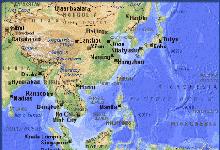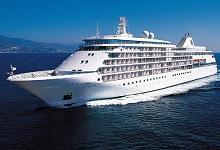Recently Viewed Cruises
- Shadow, Voyage 3307 ex Singapore ReturnAdd to favourites
- Odyssey, Indonesian Odyssey ex Benoa to SingaporeAdd to favourites
- Legend, Bangkok & Ko Samui ex Singapore ReturnAdd to favourites
- Voyager, Asia Reposition ex Perth to SingaporeAdd to favourites
- Symphony, Treasures of Southeast Asia ex Singapore to Hong KongAdd to favourites
- Royal Caribbean International raises the bar
- Classy Astor fills gap in market
- Oceanic Discoverer
- Ab Fab Oosterdam
- Catch up on Cruising: Latest cruise news in bite size
- Frequently Asked Questions
-
Shadow, Voyage 3307 ex Singapore Return
Nights 7 Ship Silver Shadow Star Rating 
Departs Singapore, Singapore Sailing 2013: 15 Mar Ports of Call Singapore, Phuket, Penang, Belawan, Port Klang (Port Kelang), Malacca Select a sailing date for approximate pricing.
Prices are per person, twin share. When booking please check current cruise fare and inclusions. Prices are indicative only, subject to currency fluctuations and may change at any time without notice.
7 Night Cruise sailing from Singapore roundtrip aboard Silver Shadow.
Launched in 2000, Silver Shadow introduced guests to the next generation of the Silversea fleet - slightly larger in size, yet just as intimate in feel. In addition the the added space, guests aboard the Shadow are greeted with Silversea's six-star personalised service and attention to detail. The Shadow is as elegant as a grand hotel, as gracious as a long-time friends' home. Each all ocean-view suite provides a sumptuous retreat. Each public space is intimate yet inviting. It's a warm feeling of home upon the seas of the earth.
Aboard Silver Shadow you will find a most accommodating place to view our world. Whether it's delicious onboard diversions, world-class cuisine, memorable dining venues or staying connected from anywhere, Silversea's impeccable standards apply to every detail of your voyage.
Highlights of this cruise:
Singapore
To arrive in Singapore is to step into a world where the call to prayer competes with the bustle of capitalism; where old men play mah-jongg in the streets and white-clad bowlers send the ball flying down well-tended cricket pitches; where Chinese fortune-tellers and high-priced management consultants advise the same entrepreneur. This great diversity of lifestyles, cultures, and religions thrives within the framework of a well-ordered society. Singapore is a spotlessly clean, modern metropolis surrounded by green, groomed parks and populated by 4.6 million orderly and well-regulated people, including many foreigners. At the southern foot of the island is Singapore city, with its gleaming office towers and working docks. Of the Singapore's total land area, more than half is built up, with the balance made up of parkland, farmland, plantations, swamp areas, and forest. Well-paved roads connect all parts of the island, and Singapore city has an excellent public transportation system.
Phuket
Ko Phuket is linked to the mainland by a causeway and to the rest of the world by an international airport. Its indented coastline and hilly interior make the island seem larger than its 48-km (30-mi) length and 21-km (13-mi) breadth. Before tourism, Ko Phuket was already making fortunes from tin mining and rubber plantations. Backpackers discovered Ko Phuket in the early 1970s. Word quickly spread about its white, sandy beaches and cliff-sheltered coves, its plunging waterfalls and impressive mountains, its cloudless days and fiery sunsets. Beautiful beaches and excellent diving and snorkeling have made Phuket one of the world's favorite islands. Although it was hit hard by the tsunami of 2004, much of the island was unaffected.
Penang
Off the Malay peninsula's west coast, Malaysia's island state of Penang (Pinang in Bahasa Malaysia, the national language) is a major vacation destination and a UNESCO World Heritage site. Known as the Pearl of the Orient for its natural beauty, Pulau Pinang respects tradition but is neither stodgy nor sleepy. It has gracious colonial architecture, vibrant Chinese communities, Indian temples, mosques, beach resorts, and enticing food. Its population is primarily Hokkien Chinese, though there's also a sizable Indian community as well as many Malays. State capital Georgetown, often confusingly called "Penang," is easy to like, with plenty of sightseeing and shopping, but you'll have to look further to find the island's best beaches.
Port Kelang
Kuala Lumpur presents modern, urban Southeast Asia in a manageable package. Malaysia's largest city-universally known as KL-is a grab bag of Malay, Chinese, and Indian cultures with European and Islamic influences. Colonial architecture mixes with modern skyscrapers; grand urban monuments obscure ancient alleyways where weather-beaten clerks tend to Oriental delights. The city isn't a particularly old one. When miners discovered tin between two murky rivers-Kuala Lumpur means "muddy confluence" in Malay-in 1857, Chinese traders promptly set up shop and the city was born. The British moved their colonial administration from nearby Selangor during the 1880s, and KL's urban sprawl began. At independence in 1957, KL became Malaysia's capital and remains the national focal point despite creation of the ultramodern, neighboring administrative capital Putrajaya.
Melaka
Melaka (or Malacca) is Malaysia's most historic city. Its origins can be traced to the 14th century with the founding of a fishing kampung (village) by a fugitive prince from Sumatra. Thanks to its strategic location on the Strait that bears its name, Melaka was, from its earliest days, an intermediary centre of trade. Sheltered from the monsoons by the island of Sumatra, the settlement was perfectly located for merchants to take advantage of the trade winds. When Singapore was still a fishing village, Melaka had already achieved fame and, by the beginning of the 16th century, was the most important port in the region. Foreign merchants traded in Indian and Persian textiles, spices from the Moluccas, silk and porcelain from China, as well as gold, pepper, camphor, sandalwood, and tin.
The prosperity of Melaka attracted the Portuguese who ousted the Sultan and established themselves as the new lords under whose rule the city continued to thrive. In the mid-1600s, a Dutch blockade and a six-month siege of the city forced the surrender of the last Portuguese governor. Over the next hundred years, the Dutch carried out an extensive building program; some of the buildings still stand in Dutch Square. When the Dutch trade began to bother the English East India Company, England's objective for control of Melaka was satisfied in the Treaty of London. In 1826, the port became a part of the British Straits Settlement along with Penang and Singapore. In the 19th century, Melaka faded into obscurity until the first rubber estate in Malaysia was established with some seedlings from Singapore's Botanical Garden. The idea caught on among Chinese and European planters and Melaka soon became one of the country's leading rubber producers.
Exploration of Melaka includes temples, churches, old Dutch houses and, close to the waterfront, a village of traditional Melakan houses. An interesting trail, called the Jerak Warison Heritage Trail, features many of the historic sights. Jonkers Street is renowned for its antique shops.







